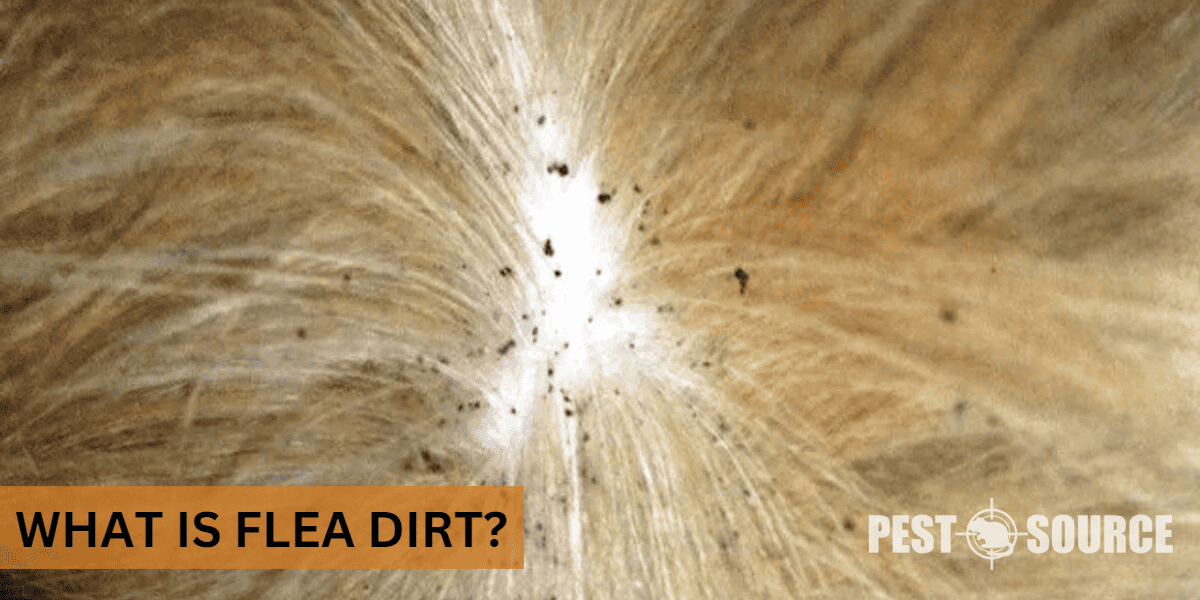Flea infestations are a common and frustrating issue faced by pet owners. One of the first signs of a potential flea infestation is the presence of what’s known as “flea dirt” on your pet’s skin and fur.
In this comprehensive guide, we’ll uncover the truth about flea dirt, learn how to identify and manage it, and explore the best prevention methods to protect your pet and home from fleas. By understanding the ins and outs of flea dirt, you can ensure the health and well-being of your beloved furry friend.
POINTS
- Flea dirt is the feces left behind by fleas after feeding on your pet’s blood, appearing as tiny black or reddish-brown specks in your pet’s fur, often around the neck and base of the tail.
- The presence of flea dirt indicates a flea infestation, which may cause various health problems for your pet, such as skin irritation, hair loss, and anemia due to blood loss.
- To manage a flea infestation, consult a veterinarian, apply appropriate flea treatments, clean the environment, and regularly inspect your pet for signs of fleas and flea dirt.
- Flea dirt can be found not only on pets but also in the home environment, such as on floors, carpets, and pet bedding, necessitating thorough cleaning to eliminate fleas and their feces.
- To prevent future infestations and flea dirt, use veterinarian-recommended flea preventives, maintain a clean home environment, and inspect your pet regularly.
What is flea dirt?
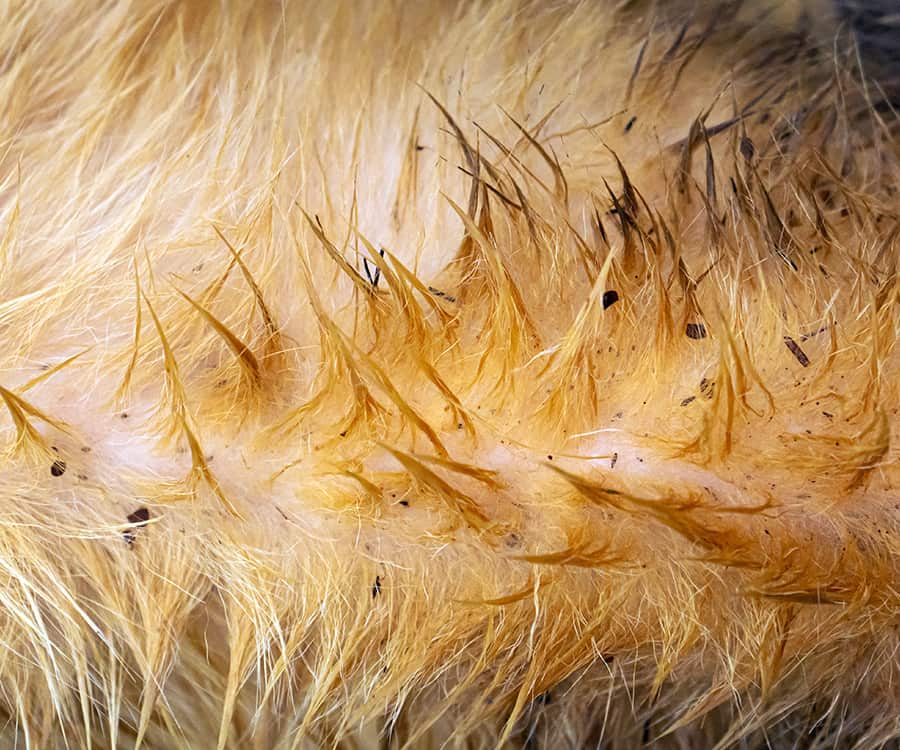
Flea dirt is a commonly used term for the small, dark feces left behind by fleas. It’s important because the presence of flea dirt often indicates that your pet has fleas, and addressing this issue promptly is essential for your pet’s health and comfort.
What is the composition of flea dirt?
Flea dirt is mainly made up of digested blood, which the fleas consume from their host. This blood meal is crucial for the fleas’ survival, and it’s also the main reason that these parasites are attracted to your pets.
How does flea dirt differentiate from ordinary dirt?
Flea dirt is different from ordinary dirt due to its composition and appearance. While regular dirt is comprised of soil, dust, and other environmental particles, flea dirt mainly consists of digested blood. Flea dirt often appears as little black specks that, when moistened, will turn reddish-brown due to the presence of blood.
The following video illustrates what flea dirt exactly looks like when moistened or dampened.
What does flea dirt look like and where is it commonly found?
Flea dirt looks like tiny black specks or pepper-like granules, usually found on your pet’s skin and fur. It’s commonly found near the base of the tail, around the neck, and other areas where fleas tend to congregate. Flea dirt can also accumulate in your pet’s bedding, on carpets, and in other areas where your pet frequently spends time.
Why is flea dirt often referred to as flea poop, flea feces, flea droppings, or flea dust?
Flea dirt is often called flea poop, flea feces, flea droppings, or flea dust because it’s the waste product left behind by fleas after they’ve consumed a blood meal from their host. These terms all describe the same substance, which serves as evidence of a flea’s presence on your pet.
Identifying Flea Dirt on Pets
How to identify flea dirt on dogs?
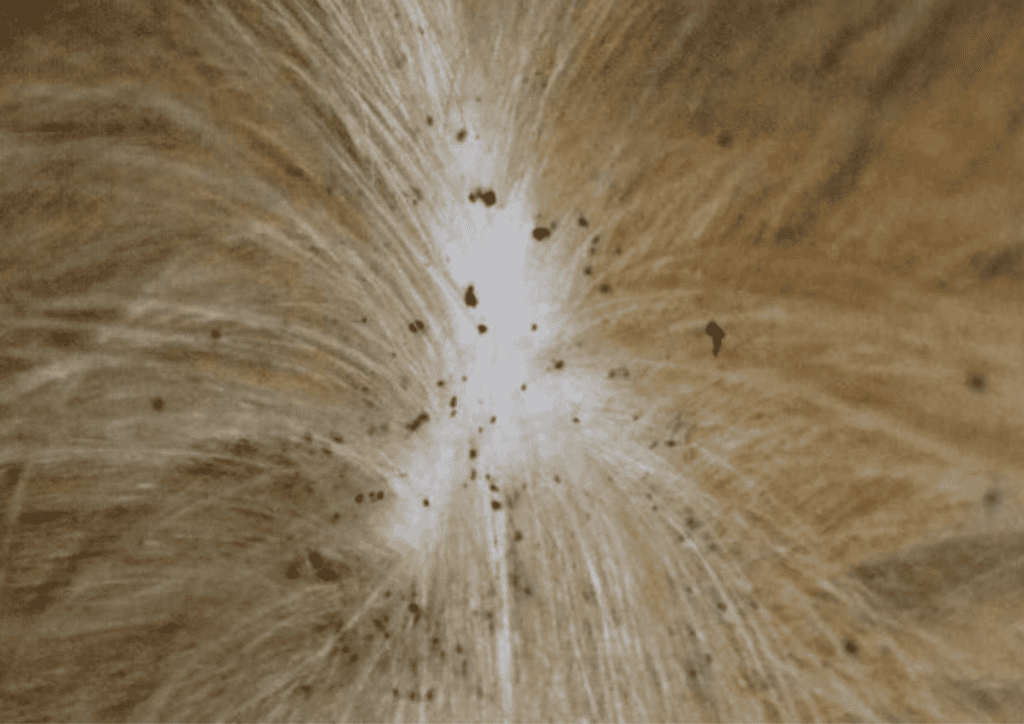
To identify flea dirt on your dog, start by carefully examining their fur, particularly in areas near the base of the tail and around the neck. Gently part the fur to expose the skin underneath and look for tiny black specks. If you’re unsure if the particles are flea dirt or regular dirt, try placing some on a moist paper towel. If the specks turn reddish-brown, you’ve found flea dirt.
How to identify flea dirt on cats?

Identifying flea dirt on cats is similar to the process for dogs. Inspect your cat’s fur, paying close attention to areas where fleas are likely to congregate, such as around the neck and at the base of the tail. Gently part the fur and look for little black specks. Test any suspect particles by placing them on a moist paper towel; if the specks turn reddish-brown, they’re flea dirt.
What do the little black dots on a pet’s skin signify?
Little black dots on your pet’s skin often signify the presence of flea dirt. These dots are the feces left behind by fleas after they’ve consumed a blood meal from your pet. If you’re unsure whether these dots are flea dirt or another substance, perform the moisture test mentioned earlier to confirm.
What do black specks in a pet’s fur imply?
When you find black specks in your pet’s fur, it’s likely that they’re flea dirt, indicating a flea infestation. These specks are digested blood left behind by fleas, and they often accumulate in areas where fleas tend to concentrate, such as around the neck and near the base of the tail.
How does flea dirt affect different types of pets?

Flea dirt affects different types of pets because it’s a sign of a flea infestation, which can lead to various health issues:
- Dogs and cats that are infested with fleas often experience itching, biting, and scratching, which can result in skin irritation, hair loss, and even infection.
- In more severe cases, a large number of fleas can cause anemia due to blood loss, posing a significant risk to a pet’s health.
Flea Dirt but No Fleas: Unpacking the Mystery
Finding flea dirt but no visible fleas on your pet can be puzzling and may indicate different scenarios regarding the health and environment of your pet. The table below outlines possible reasons for this occurrence and suggests recommended actions to effectively address and monitor the situation.
| Scenario | Possible Causes | Recommended Actions |
|---|---|---|
| Flea Dirt but No Fleas on Dogs | Fleas hiding in fur, fleas jumped off, grooming by pet | Continue flea control measures, consult veterinarian for advice |
| Flea Dirt but No Fleas on Cats | Fleas hiding due to effective grooming, fleas temporarily off pet | Monitor closely, apply or adjust flea treatments as recommended |
| Flea Dirt on the Floor but No Visible Fleas | Fleas in carpets or furniture, eggs laid off-host | Increase environmental cleaning, use indoor flea treatments |
Is it possible to find flea dirt but no fleas on pets?
Yes, it’s possible to find flea dirt on your pet but not see any live fleas. This could be due to a few reasons, such as the fleas hiding deep within the fur or jumping off your pet temporarily. It’s also possible that your pet may have groomed or scratched off some fleas, but their feces remain.
What does it mean if there’s flea dirt but no fleas on dogs?

If you find flea dirt but no fleas on your dog, it may indicate that a flea infestation has occurred or is still present. Fleas are skilled at hiding and can be challenging to spot, especially in dogs with dark or thick fur. The presence of flea dirt suggests that fleas have been feeding on your dog’s blood, and it’s essential to continue monitoring and taking steps to manage the infestation.
What does it mean if there’s flea dirt but no fleas on cats?
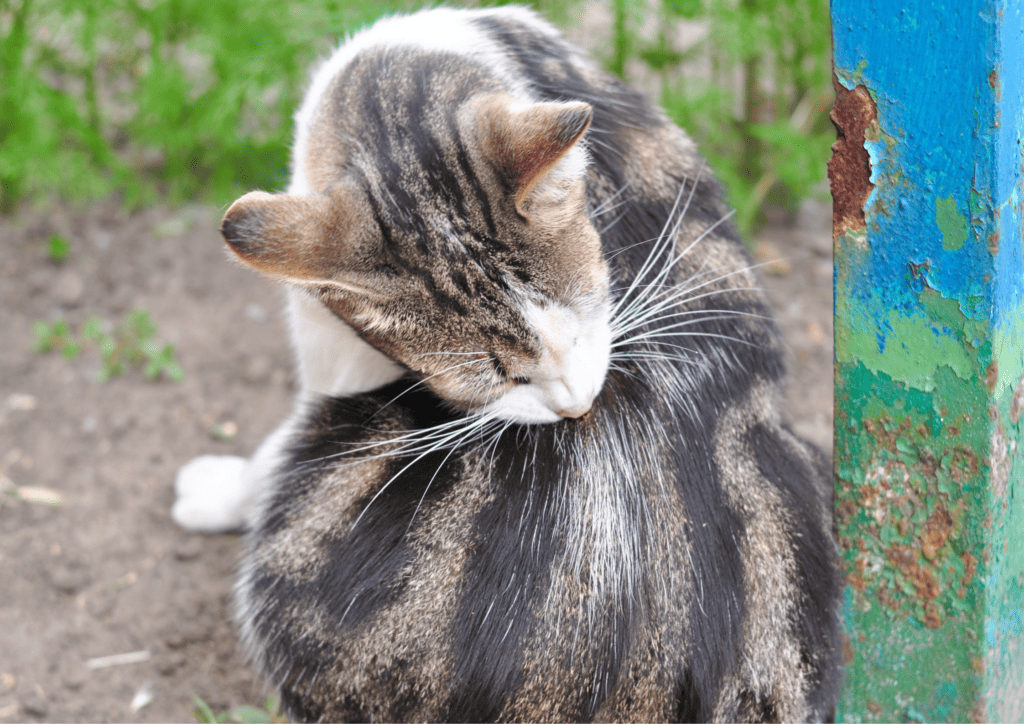
Like with dogs, finding flea dirt but no fleas on your cat implies that fleas have been present, feeding on your cat’s blood. Cats are adept at grooming themselves, which can make it difficult to spot live fleas. However, the flea dirt remaining on your cat is evidence of a flea problem, so you should vigilantly monitor your cat and take necessary steps to treat and prevent the infestation.
How to explain the occurrence of flea dirt on the floor but no visible fleas?
Finding flea dirt on the floor but not seeing any live fleas could be due to several factors:
- Flea dirt on the floor but no visible fleas may occur because fleas have temporarily jumped off your pet to lay eggs or to hide.
- Accumulation of flea dirt on the floor can also result from your pet’s movements or grooming activities.
- Fleas might be hiding deep within carpets, bedding, and furniture, making them difficult to detect.
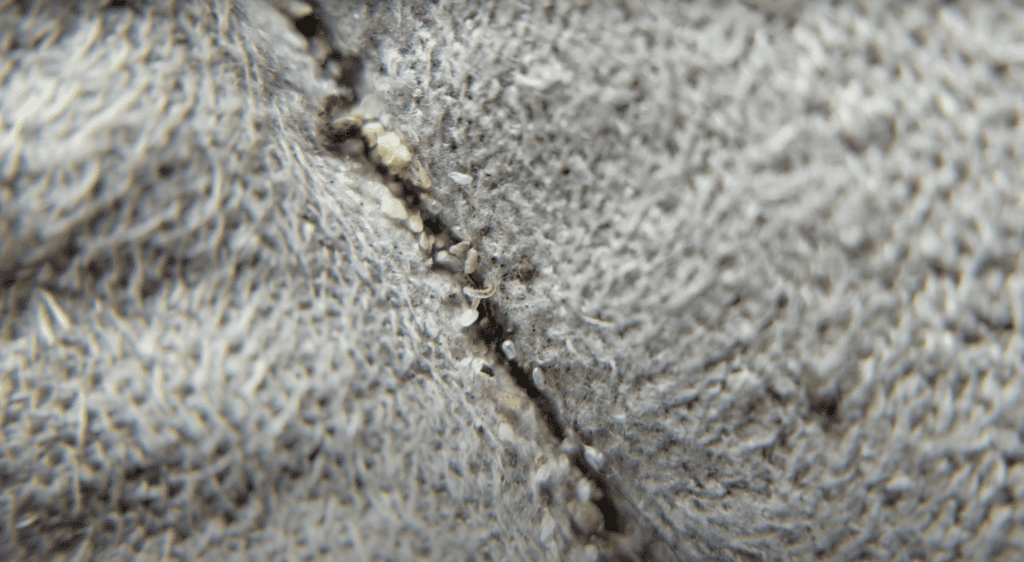
Are the tiny black dots on my pet’s skin always flea dirt?
While tiny black dots on your pet’s skin often indicate flea dirt, they can occasionally be caused by other factors. For example, some pets may have skin conditions or allergies that produce similar dark specks. If you’re uncertain about the dots’ nature, perform the moisture test or consult a veterinarian to determine if fleas are the culprit.
Flea Dirt: Sign of Flea Infestation?
Does the presence of flea dirt signify a flea infestation?
Yes, the presence of flea dirt typically signifies a flea infestation. Flea dirt is evidence that fleas have been feeding on your pet’s blood, providing a clear sign that these parasites are present and active. It’s important to address infestations quickly, as they can result in various health problems, discomfort, and even allergic reactions for your pet.
What does a high presence of flea dirt mean for the pet’s health?
A high presence of flea dirt suggests a significant infestation, which can negatively impact your pet’s health. Pets dealing with a severe flea infestation often experience itching, scratching, and biting, resulting in skin irritation, hair loss, and, in some cases, skin infections. A large number of fleas can also cause anemia due to blood loss, creating serious health risks for your pet.
How to manage a possible flea infestation upon the detection of flea dirt?

When you detect flea dirt on your pet, indicating a possible flea infestation, there are several steps to manage the situation:
- Consult a veterinarian: Schedule an appointment with a veterinarian to confirm the infestation and discuss treatment options.
- Use flea treatments: Apply effective flea treatments such as topical medications, flea shampoos, or oral medications to eliminate fleas and prevent future infestations.
- Clean the environment: Thoroughly clean your home, including bedding, carpets, and furniture, as flea eggs and flea larvae can linger in these areas. Regular vacuuming and washing pet bedding can help reduce flea populations.
- Treat outdoor spaces: If your pet spends time outdoors, use appropriate yard treatments to limit fleas’ breeding grounds.
- Stay vigilant: Regularly monitor your pet for signs of fleas and flea dirt, and reapply treatments as necessary.
Remember that flea control is an ongoing process, and it’s essential to stay proactive in managing and preventing future infestations.
Characteristics of Flea Waste
How does flea poop or droppings contribute to flea dirt?
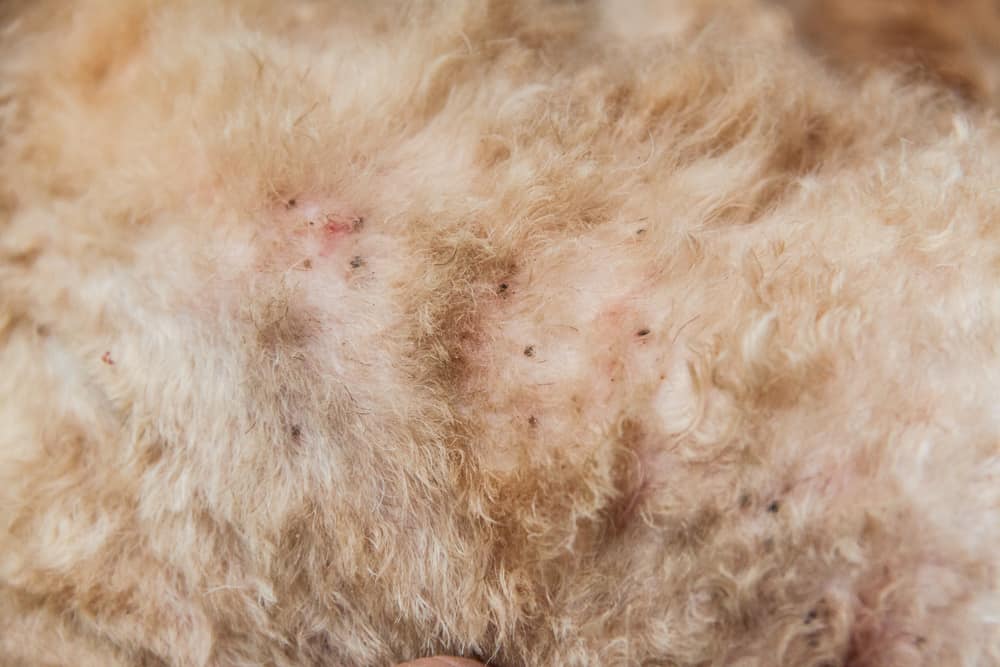
Flea poop, also known as flea droppings, is the main component of flea dirt. The digested blood that constitutes flea poop is the waste product left behind after fleas have fed on your pet’s blood. Flea dirt accumulates as these droppings pile up on your pet’s skin and fur.
What does flea poop look like on pets?
Flea poop appears as tiny, dark specks, similar in size and shape to ground pepper. These granules can vary in color from black to reddish-brown, depending on the pet’s fur color and lighting. Flea poop is often found where fleas tend to congregate, such as around the neck, near the base of the tail, and on the belly.
Is the presence of flea poop indicative of a flea problem?
Yes, the presence of flea poop on your pet is generally indicative of a flea problem. Since flea poop is made up of digested blood from your pet, it signifies that fleas have been actively feeding on your pet’s blood, resulting in an infestation that needs to be addressed promptly.
Beyond Pets: Flea Dirt in the Environment
Can flea dirt be found on floors or other surfaces in the home?
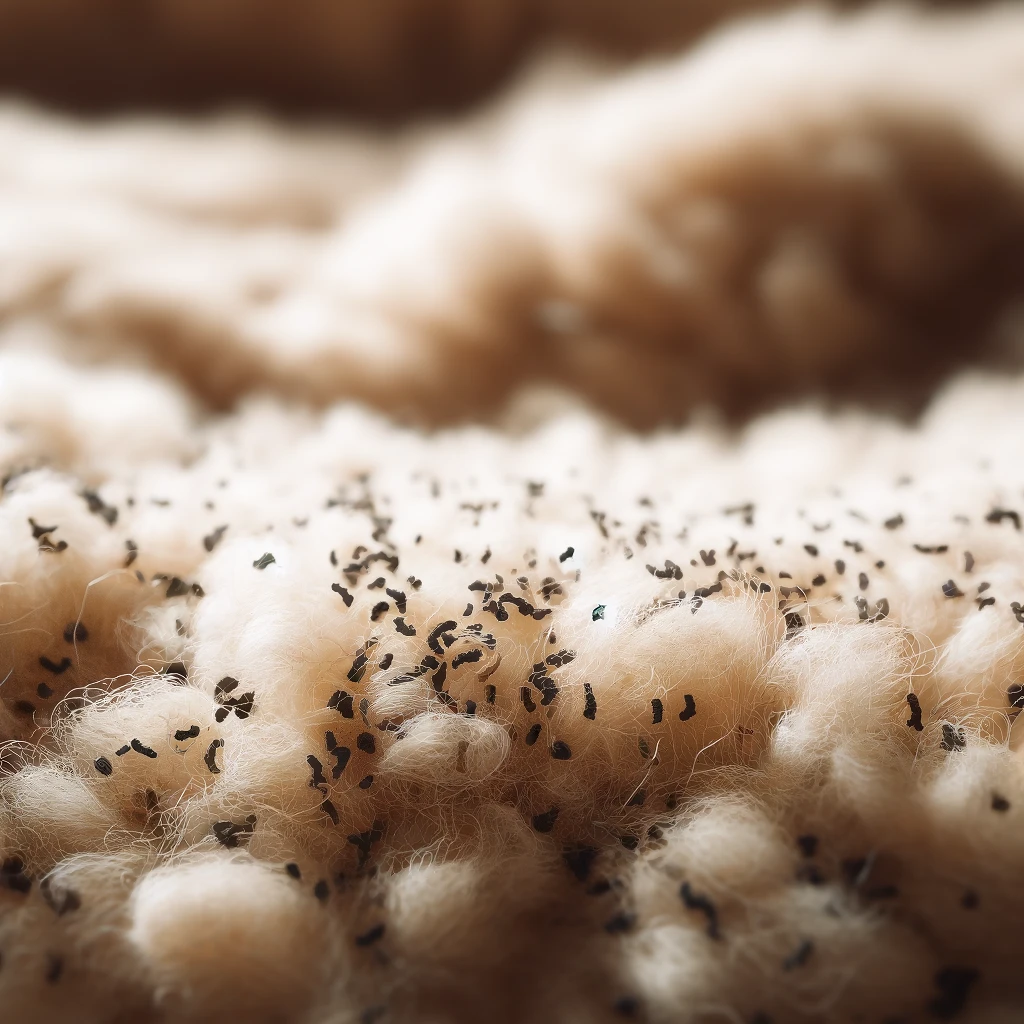
Flea dirt can indeed be found on floors and other surfaces in your home, particularly where your pet frequently spends time. This may include pet bedding, carpets, furniture, and even baseboards. Due to your pet’s movements and grooming, flea dirt can disperse throughout your home, serving as further evidence of a flea infestation.
What does it mean when flea dirt is found but there are no fleas in sight?
Finding flea dirt without seeing any live fleas could mean that fleas are hiding deep within your pet’s fur or in the surrounding environment. Fleas, in various stages of their life cycle, can be difficult to spot, especially when they’re hiding in carpets, bedding, and furniture. While flea dirt is a reliable indicator of a flea problem, the absence of visible fleas should not lead you to disregard the issue.
Management and Prevention of Flea Dirt
Effective management and prevention of flea dirt are crucial to maintaining the health and comfort of your pets. The table below outlines a structured approach for immediate actions upon identifying flea dirt, effective cleaning practices, and preventive measures to ensure that your pet and home remain flea-free.
| Category | Action | Description | Frequency |
|---|---|---|---|
| Immediate Actions | Consult a veterinarian | Reach out to a veterinarian for guidance on flea treatments and recommendations. | As needed upon detection of flea dirt |
| Administer flea treatments | Use veterinarian-recommended flea treatments such as topical medications or flea shampoos. | As prescribed | |
| Inspect your home | Look for other signs of flea infestation, such as flea dirt on floors, in carpets, and on pet bedding. | Regularly during infestation | |
| Cleaning Practices | Bathe your pet | Gently bathe your pet using a flea shampoo or mild pet shampoo. | As needed or after detecting flea dirt |
| Clean pet bedding | Launder your pet’s bedding in hot water and dry on high heat to kill fleas and eliminate flea dirt. | Regularly, especially during infestation | |
| Vacuum regularly | Vacuum your home thoroughly, focusing on areas where your pet spends the most time. | At least once a week | |
| Preventive Measures | Use preventive treatments | Regularly administer flea preventives recommended by your veterinarian. | According to the preventive schedule |
| Maintain a clean environment | Keep your home clean and vacuum frequently to decrease the likelihood of flea infestations. | Continuous | |
| Inspect your pet regularly | Regularly check your pet for fleas and flea dirt, and address any issues immediately. | At least monthly |
What immediate steps should pet owners take upon identifying flea dirt on their pets?

Upon identifying flea dirt on your pet, pet owners should take the following immediate steps:
- Consult a veterinarian: Reach out to a veterinarian for guidance on flea treatments and recommendations tailored to your pet’s specific needs.
- Administer flea treatments: Begin using veterinarian-recommended flea treatments such as topical medications, flea shampoos, oral medications, or flea collars to combat the infestation effectively.
- Inspect your home: Look for other signs of a flea infestation, such as flea dirt on floors, in carpets, and on pet bedding.
How can pet owners effectively get rid of flea dirt?

To effectively get rid of flea dirt, pet owners should:
- Bathe your pet: Gently bathe your pet using a flea shampoo or mild pet shampoo, and remove visible flea dirt using a fine-toothed flea comb.
- Clean pet bedding: Launder your pet’s bedding in hot water and dry on high heat to kill fleas and eliminate flea dirt.
- Vacuum regularly: Vacuum your home regularly, paying special attention to areas where your pet spends the most time, to remove any remaining flea dirt and decrease flea populations in the environment.
What preventive measures can pet owners adopt to avoid flea dirt in the future?

To prevent future flea infestations and avoid flea dirt, pet owners should:
- Use preventive treatments: Regularly administer flea preventives recommended by your veterinarian, such as monthly topical treatments or oral medications.
- Maintain a clean environment: Regularly clean and vacuum your home, especially your pet’s bedding, to decrease the likelihood of flea infestations.
- Inspect your pet regularly: Check your pet for fleas and flea dirt periodically, and address any potential issues immediately.
Conclusion
Flea dirt is an essential indicator of flea infestations, and understanding its significance is vital for maintaining your pet’s health and comfort. By identifying flea dirt promptly and taking proper steps to manage and prevent infestations, pet owners can effectively protect their pets from fleas and the health issues they cause.

